Making the Right Choice: Stair Lift or Home Elevator
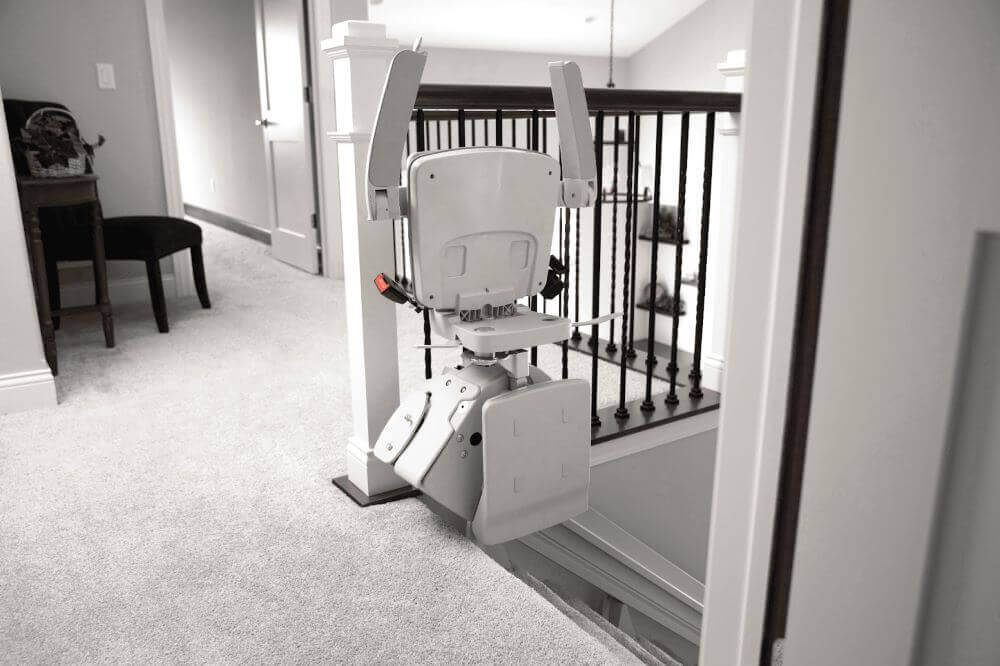
Both options offer unique benefits and can drastically improve the quality of life for individuals with mobility issues.
Still unsure of which device is right for you? Read along to know what device to install in your home now.
What Is a Stair Lift?
A stair lift is a mechanical device transporting individuals up and down stairs. They are commonly used by people who face mobility challenges due to age or health conditions.
Stair lifts provide a safe and comfortable means to maintain independence within multi-level homes.
Different types of stair lifts
Stair lifts come in various designs to accommodate individual needs and staircase configurations. Before purchasing, you must familiarize yourself with the types of stair lifts available.
Indoor stairlifts
Wheelchair users or those with limited mobility might benefit from an indoor stairlift.
They are designed to fit onto straight and curved staircases and provide users with easy access to the upper floors of a home, thus increasing accessibility.

Outdoor stairlifts
Outdoor stair lifts are designed specifically for outdoor use. They offer an easy way to access the upper levels of a home from the outdoors. They are typically constructed from weather-resistant materials to withstand harsh weather conditions and provide a secure and comfortable ride.
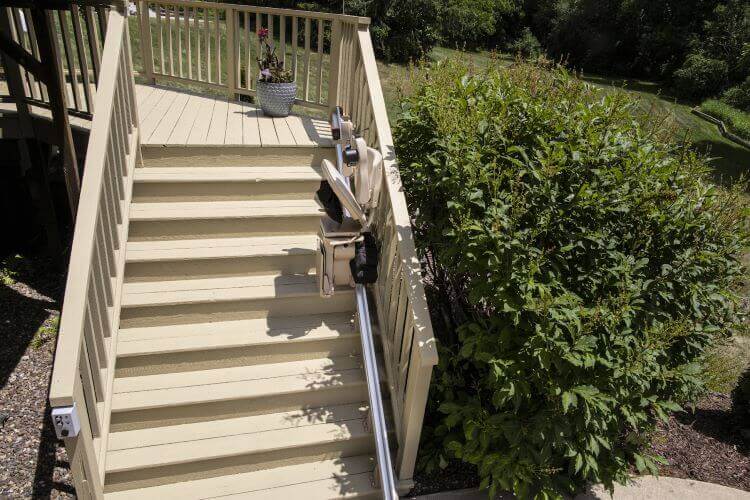
Straight stair lifts
Straight stairlifts are designed for straight stairs with no curves or turns in the staircase. They feature a chair or platform lift that travels along a straight track from the bottom to the top of the stairs.
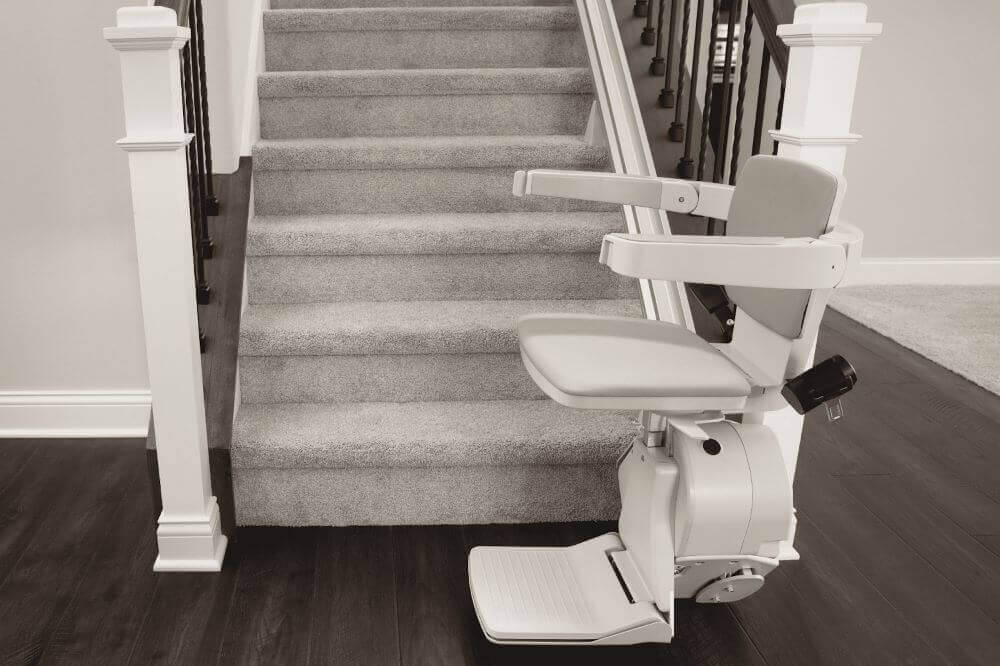
Curved stair lifts
Curved stairlifts are a great option if your stairway has bends or turns. These lifts are more expensive than the straight stairlifts but offer more convenience and flexibility.
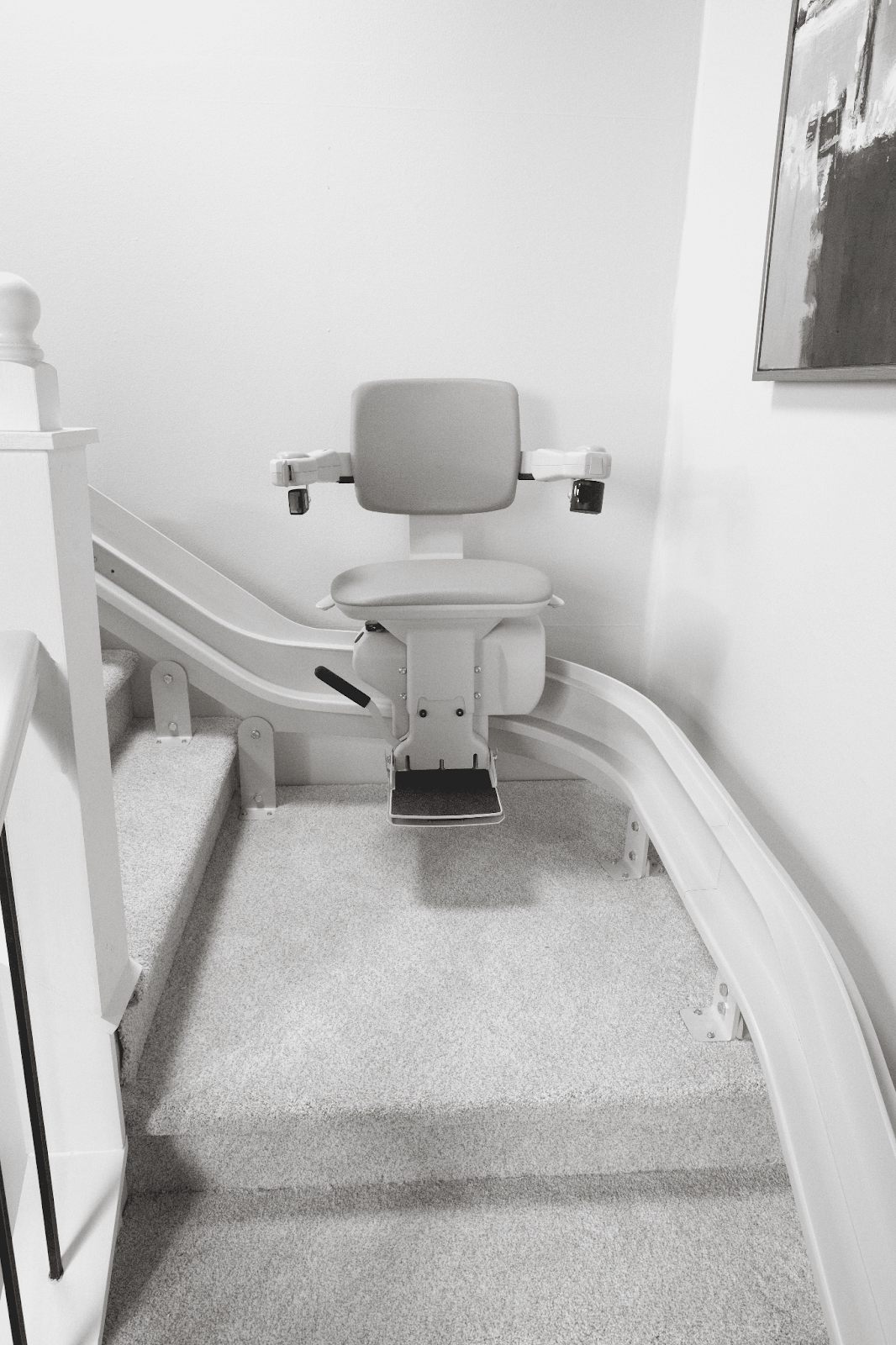
How stair lifts work
Stair lifts function on a simple yet effective mechanism. They operate on a track system affixed to the stairs’ structure. The individual chair or platform is moved along this track, powered by a battery-operated motor.
When the user is ready to ascend or descend the stairs, they sit on the lift or wheel their wheelchair onto the platform lift and activate the control buttons or remote.
Safety features like belts are available for added security during the ride. Sensors are often incorporated into the design to detect obstructions on the staircase, halting the lift’s movements until the path is clear.
This ensures safe and smooth navigation of the stairs. An added advantage of the battery-operated systems is their reliability; Even in a power outage, the stair lift continues to function on the charged batteries for a few additional cycles, allowing you to use the stairlift for a couple of trips up and down your staircase.
How are stair lifts installed?
Installing a stair lift requires professional expertise and knowledge. Generally, the installation process begins with measuring the stairs to determine the required size and type of lift.
Once this is established, a technician will typically need to mount the track to the wall or staircase and attach the motorized chair or platform.
The motor unit should be securely fastened, and all safety features, such as belts and sensors, must be installed according to the manufacturer’s instructions. All wiring should be safely tucked away, with no wires or cords visible.
Once the installation is complete, a qualified technician will test the lift and explain how to use it correctly. Properly installed stair lifts are very safe and provide individuals with limited mobility an easy way to access the upper floors of a home.
When are stair lifts best used?
Individuals who experience difficulty climbing stairs due to age or health conditions can benefit from a stair lift. Installing one in their home allows them to maintain independence while providing an easy way to access multiple levels in their residence.
Stair lifts are also helpful for those who may not require the full services of a home elevator yet still need assistance navigating their staircase.
Stairlifts can also be used in commercial settings like retail stores or multi-level offices. Installing a stair lift at your place of business makes it easier for customers and employees with limited mobility to access all building areas.
What Is a Home Elevator?
As the name suggests, a home elevator is a residential lift that provides easy access to various floors of a home. It operates similarly to elevators found in commercial buildings but is designed to blend seamlessly with residential décor and require less space.
Home elevators can significantly enhance the functionality and accessibility of a multi-story home, making them an ideal solution for individuals with mobility issues or those simply seeking added convenience and luxury in their living space.
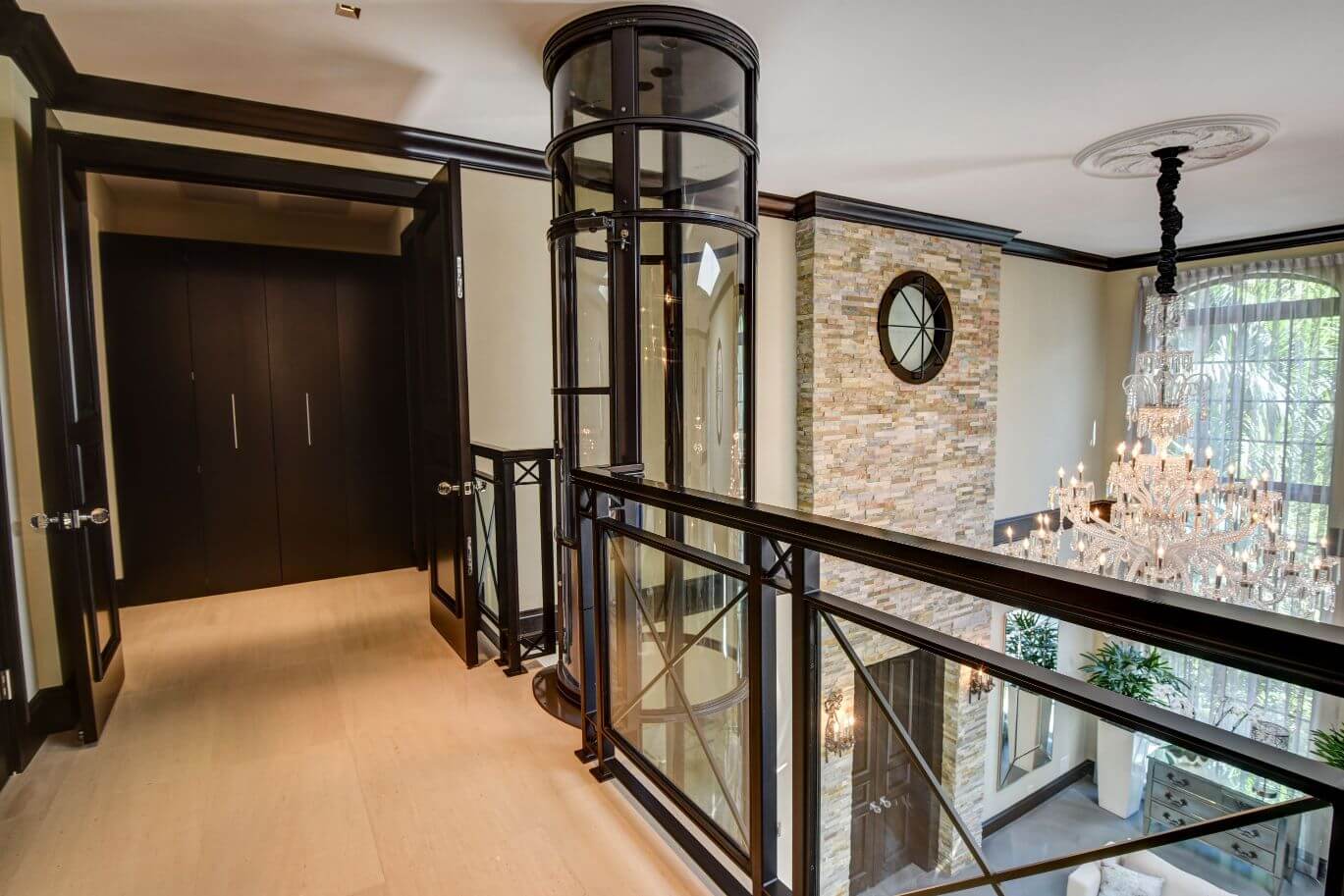
Different types of home elevators
With the number of residential elevators on the rise, homeowners have several options. The most common types of home elevators are as follows.
Pneumatic vacuum elevators
A pneumatic vacuum elevator, often called a PVE, is a modern residential lift. Unlike traditional elevators requiring cables, counterweights, or hydraulic systems, the vacuum elevator employs a unique technology that evacuates air from the chamber as it ascends, utilizing fans in the upper motor mount. Subsequently, during the descent, it relies on this vacuum principle to glide smoothly, effectively “floating” on air.

Hydraulic home elevator
A hydraulic home elevator is an example of a house lift that relies on fluid-driven pistons to move. The ascent and fall of the elevator are controlled by a mechanical, hydraulic pump that regulates the fluid in a cylinder.
Vertical platform lifts
Vertical platform lifts are designed to transport a person standing, in a wheelchair, or on a mobility scooter from one level to another vertically.
Unlike the more conventional elevators, vertical platform lifts do not require a hoistway or shaft, making them a cost-effective and space-saving solution for residential accessibility. They typically feature a platform at the base with side guards for safety and can be installed indoors or outdoors.
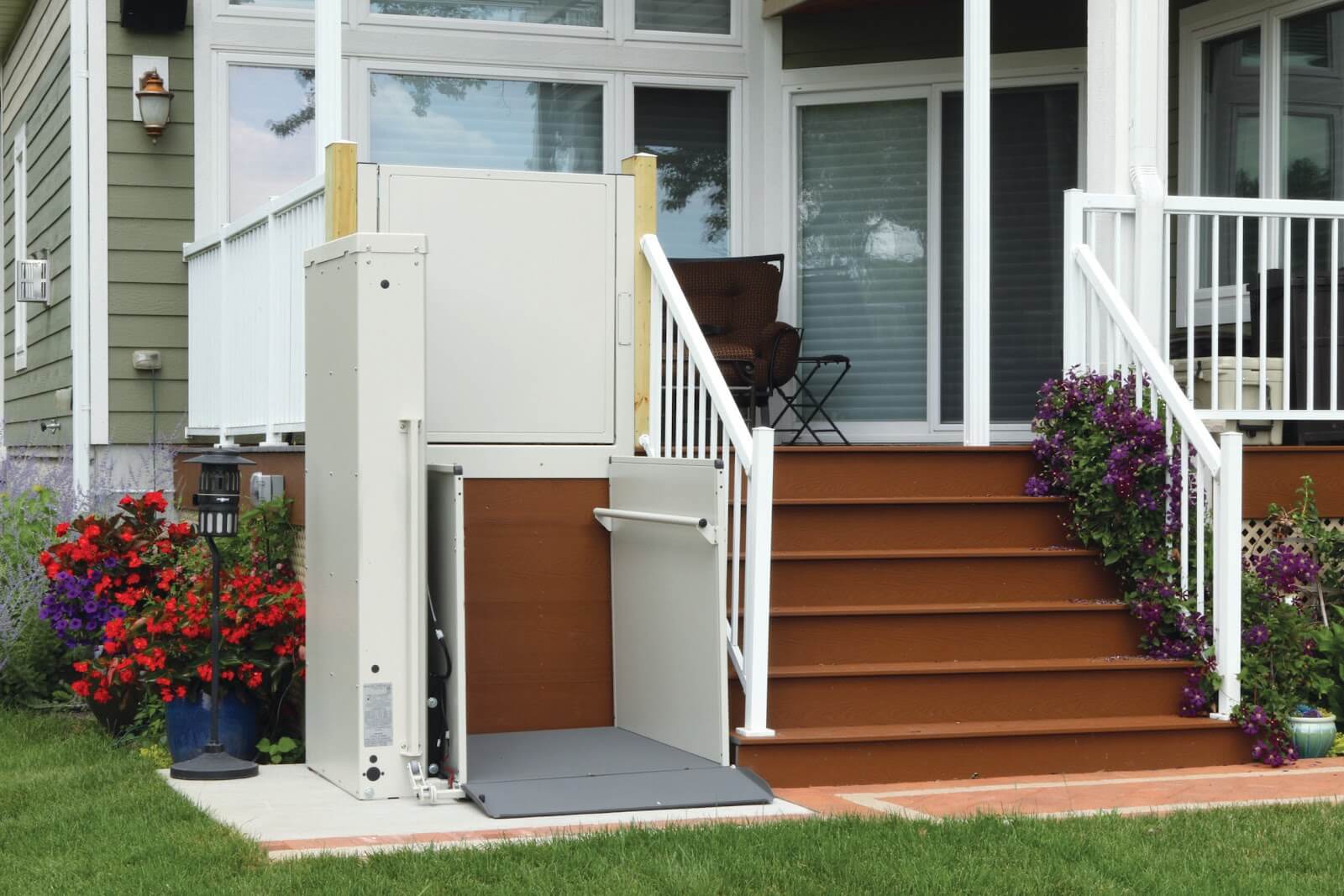
How is a home elevator installed?
Installing a home elevator involves several steps and requires a team of professionals to ensure safety and functionality. Initially, the flexible installation locations and the type of elevator chosen will determine the complexity of the process.
The first step is to construct the elevator shaft or hoistway. Depending on the elevator type and available space, this can be built inside or outside the home. Once the hoistway is completed, the rails that guide the elevator car are installed.
Following this, the elevator car and the necessary operating machinery are installed. This includes a machine that powers the movement of the elevator and a control system that manages its operation.
These components are typically installed in a space adjacent to the elevator shaft, also known as the machine room.
It’s important to note that the installation process can vary greatly depending on the type of elevator and the specific requirements of your home.
Therefore, working with a reputable elevator installation company that can guide you through the process and ensure everything is done correctly and safely is essential.
When is a home elevator best used?
Home elevators are ideal in several situations. They offer invaluable assistance for individuals with mobility issues, enabling them to navigate multi-story homes independently and safely.
This makes home elevators particularly beneficial for the elderly or those with physical disabilities.
They’re also a practical solution for families with small children, offering a safe and convenient way to move strollers or heavy items between floors.
For individuals seeking a lifestyle of luxury and convenience, a home elevator can be a significant home upgrade.
Furthermore, home elevators can increase the resale value of a property and its appeal to potential buyers, making it a worthy investment for homeowners.
Lastly, as stairs can be a potential safety risk, homes with elevators reduce such risks, providing a safer environment for all occupants.
Pros and Cons: Home Elevator vs. Stair Lift
Understanding the advantages and disadvantages of home elevators and stair lifts can aid you in finding the best solution for your particular needs.
Let’s delve into the pros and cons of each to provide a comprehensive comparison and help you make an informed decision.
The benefits of stair lifts
Regarding minimal construction, stair lifts are the way to go. Aside from this, here are some of the key advantages they can offer:
- Affordability: Compared to home elevators, stair lifts are usually more affordable, making them an excellent solution for those on a tight budget.
- Easy Installation: Stair lifts can be installed relatively quickly, often within a day, and require minimal modification to your home.
- Versatility: A stair lift installed in a home can be customized to fit various types of staircases, including straight, curved, or multi-story.
- Safety Features: The right stair lift has safety features like seatbelts, footrest sensors, and obstruction detectors; stair lifts provide secure transport up and down the stairs.
- Independence: Stairlifts enable users to move freely between the levels of their homes without assistance, promoting independence.
- Ease of Use: They are simple to operate, often with a joystick or push-button controls, making them user-friendly, especially for the elderly.
- Reduced Physical Strain: By eliminating the need to climb stairs, stair lifts help to reduce the risk of falls and lessen physical strain on the body.
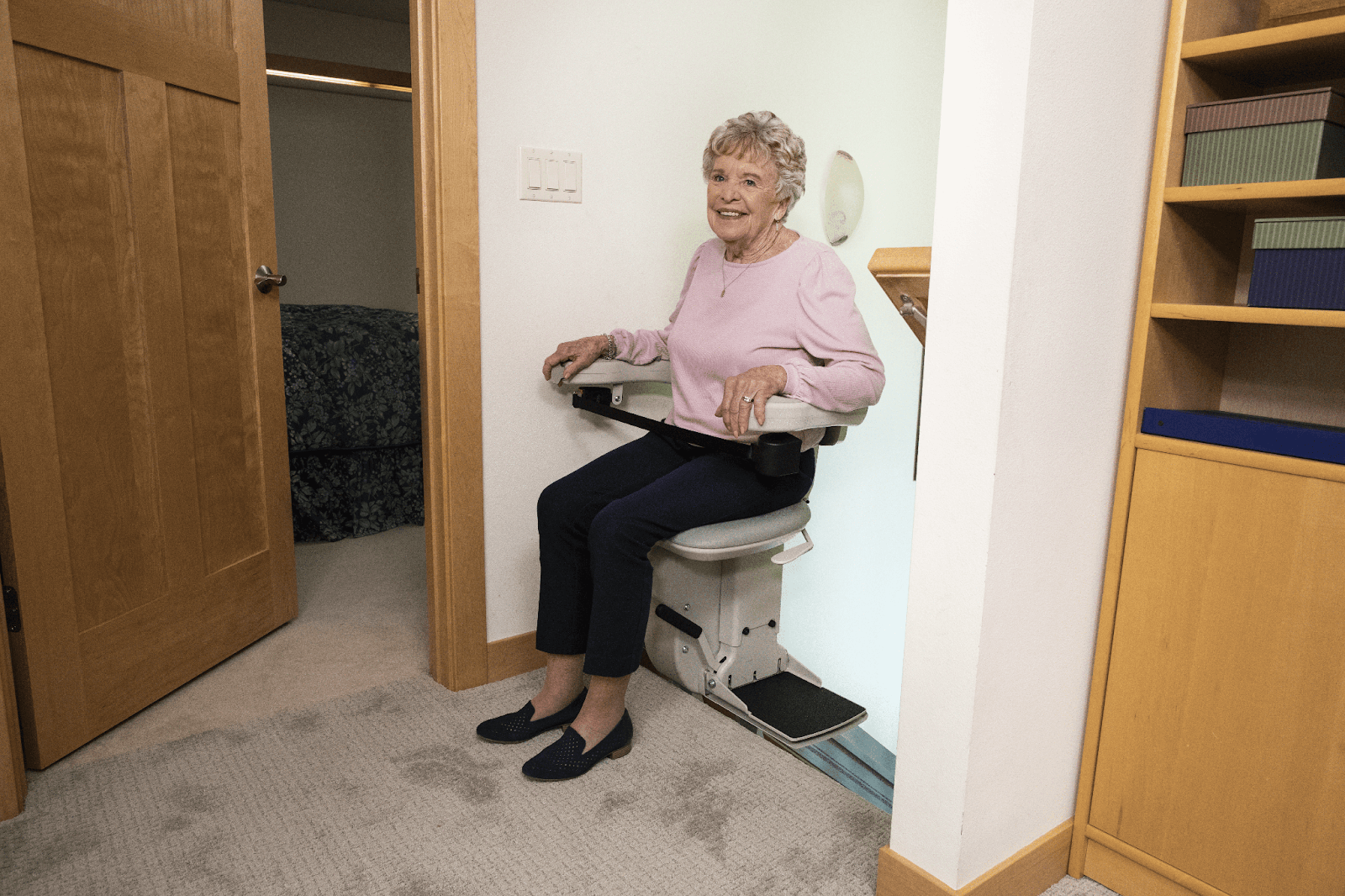
The disadvantages of stair lifts
Aside from the advantages listed above, there are a few downsides you should be aware of.
- Limited Mobility: Stair lifts only provide access to different levels of the home. For those with severe mobility issues, navigating around a floor could still be a challenge.
- Aesthetics: Some homeowners might find stair lifts visually intrusive, especially in small homes where they can become a significant feature.
- Requires User Transfer: Users must transfer from a wheelchair to the stair lift seat and vice versa, which may be difficult for some individuals.
- Occupies Stair Space: When not in use, a stair lift can take up valuable space in the stairway, potentially hindering others from using the stairs.
The benefits of home elevators
A home elevator is the way to go when dealing with more than one person, multiple pieces of furniture, or larger items. Here are some of the main advantages they offer:
- Roomy and Comfortable: Home elevators provide more room than stair lifts and greater comfort for passengers thanks to their spacious design that can accommodate multiple passengers.
- Mobility: Home elevators provide access to all home floors, allowing users to move around freely and independently more easily.
- Luxury and Convenience: Elevators offer unparalleled convenience, transforming homes into luxury abodes while adding significant value to the property.
- Safety: Thanks to sophisticated safety features such as emergency stop buttons, interlocks on the hoistway doors, and obstruction detectors, home elevators ensure a safe ride for all occupants.
- Space Savings: Home elevators save more space than stair lifts because they don’t require a continuous track and can be installed within their own enclosed structure, offering greater versatility for homes with limited or unconventional layouts.
- Variety of Designs: With various designs available, from traditional to contemporary, you can choose a style that best reflects your home and personal taste.
- No Transfer Required: Home elevators enable wheelchair users to remain in their chairs as they move between floors, eliminating the need for uncomfortable transfers.

The disadvantages of home elevators
Parallel to the numerous benefits home elevators offer, there are some potential disadvantages to consider:
- Expense: Home elevators tend to be more expensive than stair lifts, making them a less affordable option for those on a budget.
- Installation Complexity: Elevator installations usually require more complex construction work, increasing the time and cost involved.
- Maintenance: Home elevators require regular maintenance and servicing to ensure they run efficiently and safely.
Key Factors in Choosing: Stair Lift vs. Home Elevator
When choosing between a stair lift and a home elevator, several key factors come into play that can greatly influence your final decision.
Passenger capacity and weight capacity
Understanding the weight and passenger capacity of stair lifts and home elevators is crucial when choosing a mobility aid.
Stair lifts are designed for single-person use, typically holding an average weight of up to 400 pounds. They can comfortably accommodate one person with limited mobility or a person using medical equipment such as a walking frame.
On the other hand, home elevators can carry multiple passengers simultaneously or one passenger with a wheelchair. They can typically hold between 500 to 950 pounds, making them suitable for individuals with heavier wheelchairs or other medical equipment.
Space constraints
Considering space constraints is crucial when deciding between a stair lift and a home elevator.
Stair lifts require a clear pathway along the staircase and can fit most stair configurations. However, they may need to be more suitable for extremely narrow stairways or those with tight turns.
In contrast, home elevators require a dedicated area on each floor, which may necessitate substantial modifications to your home’s layout.
Measure your available space and consult a professional to identify which option fits best within your home’s existing architecture.
Type of usage
The usage type should also be considered when choosing between a stair lift and a home elevator.
Stair lifts are more suitable for those who need occasional access to different floors or assistance getting up and down the stairs.
Home elevators are ideal for those with multiple family members, enhancing accessibility and convenience within homes. They are commonly used to assist individuals with mobility challenges to move between different floors effortlessly and safely.
They benefit users with more severe mobility issues who need to move freely and without assistance.
Budgetary considerations
Stair lifts are generally less expensive, ranging from $2,000 to $25,000, depending on the model and specifications. This cost typically excludes installation, and additional servicing and maintenance expenses may be additional.
Home elevators, on the other hand, are a more substantial investment. Costs can range from $25,000 to $70,000, including installation. These figures can increase depending on the elevator’s model, customizations, and the complexity of the installation process.
While the upfront cost of a home elevator is higher, it may be a worthwhile investment if you plan to stay in your home long-term or have severe mobility restrictions.
Considering these costs in the context of your budget and needs is crucial. Consult with professionals and seek financial assistance or grants to offset some of these expenses.
Maintenance and energy costs
Maintenance and energy costs also play significant roles when deciding between a stair lift and a home elevator.
Stair lifts require regular maintenance to ensure smooth and safe operation. This usually involves cleaning the track, ensuring the battery is charged, and checking the safety sensors for obstructions.
Maintenance costs can range from $100 to $350 per hour, depending on the model and the service provider. Energy-wise, stair lifts use minimal electricity and can run on a standard residential electric circuit, making them a cost-effective option.
On the other hand, home elevators require more extensive maintenance to ensure their safety and longevity. This can include professional checks of the cab, pulley system, doors, and emergency systems.
Annual maintenance costs can range from $500-$600, and this can increase if any repairs are required. Regarding energy use, home elevators generally consume more electricity than stair lifts. However, energy-efficient models are available that minimize power consumption.
Which Is Better: Stair Lift or Home Elevator?
Ultimately, the best choice between a stair lift and a home elevator depends on your needs and budget.
If you’re considering a stair lift or a home elevator, it’s essential to weigh all the factors involved — space constraints, usage requirements, budget, energy costs, and maintenance — before deciding.
At Ascend Residential Elevators & Lifts, we understand that everyone has different needs regarding home accessibility solutions. Our experienced professionals are here to help you make an informed decision and find the best option for your home.
Get in touch with us today to learn more!
